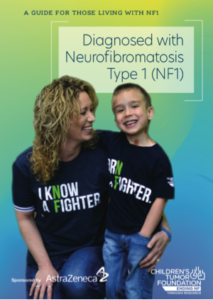Neurofibromatosis type 1 (NF1)
 Neurofibromatosis type 1 (NF1), formerly known as von Recklinghausen NF or Peripheral NF, is the most common of the three types of neurofibromatosis, and is also one of the most common inherited neurological disorders, affecting about 1 in 3,000 people throughout the world.
Neurofibromatosis type 1 (NF1), formerly known as von Recklinghausen NF or Peripheral NF, is the most common of the three types of neurofibromatosis, and is also one of the most common inherited neurological disorders, affecting about 1 in 3,000 people throughout the world.
The disorder is characterized by multiple café au lait (light brown) skin spots and neurofibromas (small benign growths) on or under the skin, and/or freckling in the armpits or groin. About 50% of people with NF1 also have learning challenges. Softening and curving of bones, and curvature of the spine (scoliosis) may occur in some patients with NF1. Occasionally, tumours may develop in the brain, on cranial nerves, or on the spinal cord. While NF tumours are generally not cancerous, they may cause health problems by pressing on nearby body tissue. Sometimes a benign tumour may become malignant (cancerous), but most people with NF1 will never develop a malignant tumour. NF1 is usually diagnosed in childhood.
Although blood tests are available for NF1, a clinical diagnosis, or a medical examination of the body, by a physician is considered to be the most reliable. The diagnostic criteria for NF1 are listed below. In order to make a diagnosis of NF1, an individual must have two or more of the following, provided that no other disease accounts for the findings:
- Family history of NF
- Six or more light brown (“cafe-au-lait”) spots on the skin (5 mm or larger in pre-pubertal individuals, or 15 mm or larger in post-pubertal individuals)
- Presence of two or more neurofibromas of any type, or one or more plexiform neurofibromas
- Freckling under the arms or in the groin area
- Two or more pigmented, benign bumps on the eye’s iris (Lisch nodules).
- A distinctive bony lesion: dysplasia (abnormal growth) of the sphenoid bone behind the eye, or dysplasia of long bones, often in the lower leg
- Tumour on the optic nerve that may interfere with vision
Genetic testing for NF1 can be done, but is a personal choice. Genetic testing can be informative for other family members or for deciding about reproductive options. It can also help to further confirm a genetic diagnosis, or help to diagnose a young child who has not yet developed enough signs to make a clinical diagnosis of NF1.
Genetic testing cannot predict the severity or specific complications in any individual case of NF1. A genetics healthcare provider or genetic counselor can help you make a decision on whether to have testing.
Because NF1 involves many different systems of the body, and cases of NF1 vary from patient to patient, doctors and staff from many different specialties may be involved in the care and treatment of an NF1 patient, such as dermatologists, neurologists, ophthalmologists, orthopedists, psychologists, oncologists, cardiologists, and genetic counselors. It is important for patients to consult these specialists, as they can lead patients to the NF specialists and doctors most helpful to their particular case of NF1.
Additionally, the research being funded by the Children’s Tumor Foundation in New York, and its partners, is ongoing and focused on ways to identify candidate drug therapies that could lead to treatments for NF1. These include treatments that may enable the shrinking or halting of the growth of tumours associated with NF1.
Manifestations of NF1
NF1 can manifest very differently from patient to patient, and no one person will have all of the possible symptoms of NF1. The severity of NF1 ranges from extremely mild cases to more severe cases, in which one or more serious manifestations may develop. There is no way to predict who will have a mild case and who will develop more serious symptoms, but the majority of those with NF1 will have minor cases (60%).
These flat, light brown spots are not harmful. People with NF1 have six or more café-au-lait spots.
Dermal neurofibromas can be cutaneous (on the skin surface) or subcutaneous (under the skin) and are lumps that are very typical to NF1. Most are not a medical issue, but can cause pain and itching. Plexiform neurofibromas are less common, occurring in about 25% of NF patients. They can grow large, and can cause problems such as pressure on nerves and organs. These types of neurofibromas can become malignant in a minority of cases (10%).
Lateral curvature of the spine, known as scoliosis, is common in NF1. In most cases it is mild and appears during the teenage growth spurt. In more severe cases, it appears in early childhood and requires close monitoring.
Intelligence in NF1 is usually in the normal range, but children may need extra help in school. Learning challenges occur in about 50% of children with NF1.
Children and adults with NF1 often have a large head circumference, which usually does not indicate any significant medical problem.
Most individuals with NF1 will start puberty during the expected age range, but some may experience either delayed or early puberty. This is frequently, but not exclusively, associated with optic pathway tumours.
Many people with NF1 are shorter than average, but it does not cause any health concerns. In rare circumstances, this may be treated with growth hormone.
An optic glioma is a tumour that develops in the cells surrounding the optic nerve (the nerve which controls vision). About 15% of children with NF1 will develop an optic glioma, with the majority of the risk before the age of six years. Most of the time, optic gliomas do not cause any symptoms and do not require treatment, but some can affect vision and may require chemotherapy
The varieties of bone defects seen in NF1 are usually evident at birth, and most are uncommon. Defects can occur in almost any bone, but are seen most often in the skull and limbs. They include:
- Congenital absence of the orbital wall, the bone normally surrounding the eye. Its absence may cause slight bulging of the skin around the eye.
Bowing of the leg bones below the knee (tibia or fibula) occurs in about 5% of patients.
NF1 can result in cosmetic issues in a number of ways. For example, skin neurofibromas may develop on the face or on exposed areas of the arms or legs. The larger and deeper plexiform neurofibromas may grow anywhere and affect the appearance of any part of the body.
For a small percentage of people, hypertension is one of the most serious complications of NF1. People with NF1 should have their blood pressure checked at least annually.
Our new "Navigating Health Transitions: A Guide for Young Adults with NF” is specifically tailored for young adults with NF1. This comprehensive resource is designed to simplify the journey of transitioning from pediatric to adult healthcare. What's inside:
- Understanding the Transition: A breakdown of the shift from pediatric to adult healthcare.
- Practical Tips: Insights and advice to empower young adults in taking charge of their medical well-being.
- Support Systems: Information on building a robust support network for a seamless healthcare journey.
Download your copy of this handbook and make it your companion on the path to greater independence and empowered health management. You can download your free copy of the resource by clicking on the button below.

